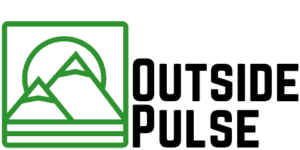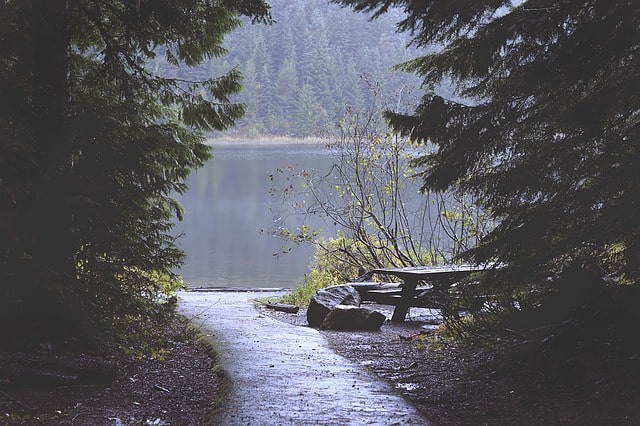As much as we might hope for it, every camping day is not going to be a sunny day filled with perfect weather. While camping in the real World you are bound to run into an occasional day or couple of days of foul weather filled with rain and wind. As the old saying goes expect the best but prepare for the worst and in order to accomplish this you must pick the best tent for rain and wind. By doing this you will be ready no matter what mother nature throws your way.
Best Tent for Rain and Wind
Teton Sports Mountain Ultra Tent
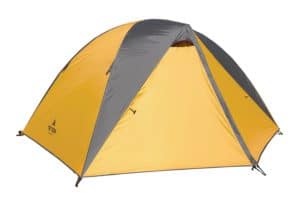 The Teton Sports Mountain Ultra Tent is everything you would want in a tent, its meant to stand up to the elements and mother nature no matter what comes its way. The tent is lightweight and durable, can be easily set up by one person, and is built to be long-lasting and durable.
The Teton Sports Mountain Ultra Tent is everything you would want in a tent, its meant to stand up to the elements and mother nature no matter what comes its way. The tent is lightweight and durable, can be easily set up by one person, and is built to be long-lasting and durable.
The Teton Sports Mountain Ultra Tent comes in four available sizes ranging from a single person tent all the way up to the largest four-person tent allowing you to pick the best tent size for your camping party needs.
This tent easily made our best tent for rain and wind list due to its rugged and waterproof design. To start from the bottom up, the tent comes with a footprint to help keep the bottom of the tent dry and out of the mud. While this might seem like a simple addon surprisingly many tents do not come with a footprint and you have to buy one separately. The Teton Sports Mountain Ultra Tent also features an extra high bathtub design with reinforced heat taped seams that help ensure that the elements stay outside the tent and keep you nice and dry inside.
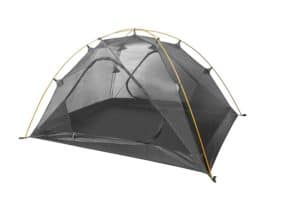 When the weather isn’t rainy or windy you can opt to use the tent with just its inner framework that includes the 2 pole tent construction and full micro-mesh top allowing for unparalleled views of the night’s sky while sleeping under the stars. But when the weather turns sour you can quickly attach the waterproof rain fly that extends all the way to the ground ensuring that the rain and wind stay on the outside of the tent where it belongs.
When the weather isn’t rainy or windy you can opt to use the tent with just its inner framework that includes the 2 pole tent construction and full micro-mesh top allowing for unparalleled views of the night’s sky while sleeping under the stars. But when the weather turns sour you can quickly attach the waterproof rain fly that extends all the way to the ground ensuring that the rain and wind stay on the outside of the tent where it belongs.
Coleman Evanston Screened Tent
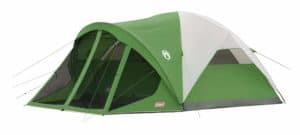 The Coleman Evanston Screened Tent is the largest tent on this list that comes in both a 6 and 8 person version. If you have a large camping party and need the extra space the Coleman Evanston Screen Tent is a great choice.
The Coleman Evanston Screened Tent is the largest tent on this list that comes in both a 6 and 8 person version. If you have a large camping party and need the extra space the Coleman Evanston Screen Tent is a great choice.
One of the most prominent features on this tent is the screened porch at the front of the tent. Having a screened porch on this tent certainly sets it apart from the crowd and makes a great addition to the tent. In essence, this screened porch creates a second room for the tent and allows you to enjoy the sites and sounds of nature minus the bugs.
The Coleman Evanston Screen Tent is great in both sunny and rainy and windy weather. The tent features several meshed screened opening for those hot sunny days to keep the tent cool and comfortable even on the hottest of summer days.
When the weather turns on you though and rain and thunderstorms are approaching your campsite you can be confident that you came prepared with this Coleman tent. The tent has many features that will help it stand up to most any weather mother nature throws its way.
To begin with, this Coleman tent offers welded floors and inverted seams ensuring that no matter how wet it gets outside the tent, inside the tent is sure to be nice and dry.
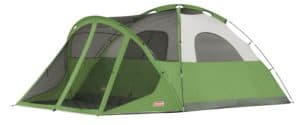 This tent also offers a large rainfly that partially covers the screened porch to provide protection from the rain and the elements. Finally, the tent features a wind strong frame that was engineered to handle strong winds for more stability in windy weather.
This tent also offers a large rainfly that partially covers the screened porch to provide protection from the rain and the elements. Finally, the tent features a wind strong frame that was engineered to handle strong winds for more stability in windy weather.
ALPS Mountaineering Taurus 4-Person Tent
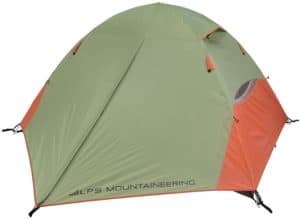 The ALPS Mountaineering Taurus is a great addition to any campers gear, the tent has loads of features but still maintains an affordable price.
The ALPS Mountaineering Taurus is a great addition to any campers gear, the tent has loads of features but still maintains an affordable price.
Everything about this tent indicates the high level of design and care that ALPS Mountaineering puts into their tents. From the durable rugged features such as fiberglass tent poles to simple add-ons like mesh storage pockets and gear loft, you can tell that ALPS Mountaineering is committed to creating quality camping products.
Some of our favorite features of this tent are the two-door design with large vestibules over each providing a ton of versatility and utility. Also with the two large vestibules on either side of the tent, it offers ample space to store your hiking boots etc… that doesn’t necessarily need to be inside the tent but you still want to keep under cover and dry.
We also really like all the storage options found throughout the tent to help you stay organized while camping including the several mesh pockets on the interior sides of the tent as well as a good size gear loft at the top of the tent to store larger items that you want to store out of the way.
The tent can handle both warm weather and rainy windy weather with ease. When its warm and sunny outside the tent offers several screened mesh openings that create an excellent airflow inside the tent to keep the tent cool and comfortable.
As great as the ALPS Mountaineering Taurus 4-Person Tent does at keeping the tent cool during warm weather, it really shines in rainy and windy weather. This tent has been engineered to handle the lightest misting of rain to a severe thunderstorm with relative ease.
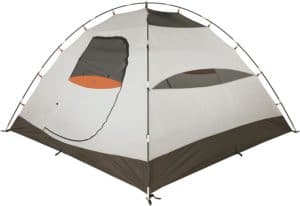 This ALPS Mountaineering tent offers factory sealed seams to keep the rain and elements on the outside of the tent, as well as a weather, coated polyester rainfly that keeps the inside of the tent nice and dry. Also, thanks to its dome tent design and fiberglass poles that tent is very secure and safe feeling even on the windiest of days.
This ALPS Mountaineering tent offers factory sealed seams to keep the rain and elements on the outside of the tent, as well as a weather, coated polyester rainfly that keeps the inside of the tent nice and dry. Also, thanks to its dome tent design and fiberglass poles that tent is very secure and safe feeling even on the windiest of days.
Parts of a Tent that Provide Protection from the Rain
There are several important parts that any tent must have to provide the ultimate in rain and wind protection while camping. While any combination of these features will provide a certain degree of protection, combining them all together will ensure that you have the best protection while camping in the rain and wind.
 Rainfly – This is one of the most critical aspects of any tent during rainy weather. The rainfly provides a waterproof cover that attaches to the top of the tent ensuring the rain sheds off and down the tent instead of inside it. Rainfly’s can come in all shapes and sizes and cover just the top of the tent or extend all the way to the ground. For the best protection from the elements you ideally want a rainfly that extends all the way to the ground and is 100% waterproof.
Rainfly – This is one of the most critical aspects of any tent during rainy weather. The rainfly provides a waterproof cover that attaches to the top of the tent ensuring the rain sheds off and down the tent instead of inside it. Rainfly’s can come in all shapes and sizes and cover just the top of the tent or extend all the way to the ground. For the best protection from the elements you ideally want a rainfly that extends all the way to the ground and is 100% waterproof. 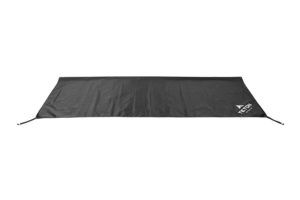 Footprint – Once the top of your tent is protected from the elements it’s important to protect it on the bottom as well. While you can get by without a footprint when using a tent it’s highly recommended to help keep the floor of the tent dry and out of the elements. There is nothing particularly complicated about a tent footprint, it is typically a little larger than the bottom dimensions of the tent, made from waterproof materials often times something similar that the tent is made from, and has the ability to be staked down to make sure that it stays in place while using it.
Footprint – Once the top of your tent is protected from the elements it’s important to protect it on the bottom as well. While you can get by without a footprint when using a tent it’s highly recommended to help keep the floor of the tent dry and out of the elements. There is nothing particularly complicated about a tent footprint, it is typically a little larger than the bottom dimensions of the tent, made from waterproof materials often times something similar that the tent is made from, and has the ability to be staked down to make sure that it stays in place while using it.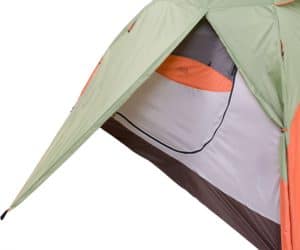 Vestibules – Vestibules can be thought of as a front or back porch on a tent. They are typically incorporated into the rainfly of the tent and extend beyond the entrance of the tent to provide an area of cover that goes beyond the interior of the tent. Vestibules do a great job of keeping extra gear or perhaps your hiking boots dry even if they are not on the interior of the tent. They also help keep the ground dry in front of the tent entrance, which helps in not tracking rain and mud inside of the tent.
Vestibules – Vestibules can be thought of as a front or back porch on a tent. They are typically incorporated into the rainfly of the tent and extend beyond the entrance of the tent to provide an area of cover that goes beyond the interior of the tent. Vestibules do a great job of keeping extra gear or perhaps your hiking boots dry even if they are not on the interior of the tent. They also help keep the ground dry in front of the tent entrance, which helps in not tracking rain and mud inside of the tent. 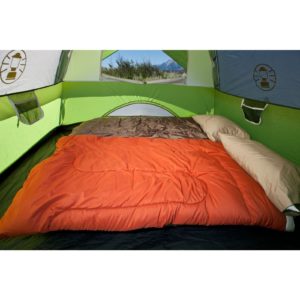 Bathtub – Beyond the footprint, a good quality tent will have its own built-in protection for the bottom of the tent to keep you and your gear dry. The term bathtub when it comes to tents refers to the bottom portion of the tent the include the floor of the tent and typically comes up the side of the tent 4 to 6 inches. While your bathtub at home is meant to hold water in, the bathtub on a tent is meant to keep water out. Bathtubs on tents are made from waterproof and very durable materials with double seams or heat seams ensuring that the mud and water stay on the outside of the tent. In the picture to the right, the bathtub is the black material at the bottom of the tent.
Bathtub – Beyond the footprint, a good quality tent will have its own built-in protection for the bottom of the tent to keep you and your gear dry. The term bathtub when it comes to tents refers to the bottom portion of the tent the include the floor of the tent and typically comes up the side of the tent 4 to 6 inches. While your bathtub at home is meant to hold water in, the bathtub on a tent is meant to keep water out. Bathtubs on tents are made from waterproof and very durable materials with double seams or heat seams ensuring that the mud and water stay on the outside of the tent. In the picture to the right, the bathtub is the black material at the bottom of the tent.
Parts of a Tent that Provide Protection from the Wind
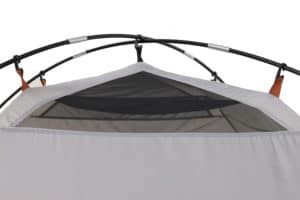 Strong Tent Poles – The tent poles are what provides the structure to the tent and allows it to hold and maintain its shape. When picking a tent you want to make sure the tent has quality tent poles that will stand up to high winds. Tent poles can be made from many different materials but two of the most common are aluminum and fiberglass. Either material can be a good choice just make sure that they are well made and can withstand high winds.
Strong Tent Poles – The tent poles are what provides the structure to the tent and allows it to hold and maintain its shape. When picking a tent you want to make sure the tent has quality tent poles that will stand up to high winds. Tent poles can be made from many different materials but two of the most common are aluminum and fiberglass. Either material can be a good choice just make sure that they are well made and can withstand high winds. 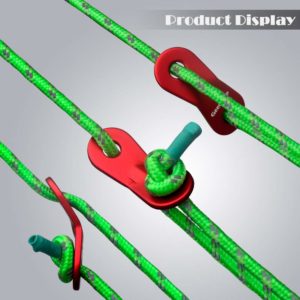 Guy Lines – After the tent poles the guy lines are the next most important thing that provides stability in windy weather. Guy lines are typically made from durable rope or nylon. They attach to various points on the tent and extend down to the ground where they are staked in to provide extra support to the tent during high winds.
Guy Lines – After the tent poles the guy lines are the next most important thing that provides stability in windy weather. Guy lines are typically made from durable rope or nylon. They attach to various points on the tent and extend down to the ground where they are staked in to provide extra support to the tent during high winds. - Stakes – Perhaps one of the most basic parts of any tent are the stakes that are used to stake down the four corners of the tent. Just because tent stakes might be basic tent technology doesn’t make them any less vital though especially during windy situations while camping. Typical tent stakes are made from plastic or metal and help secure the tent in place and
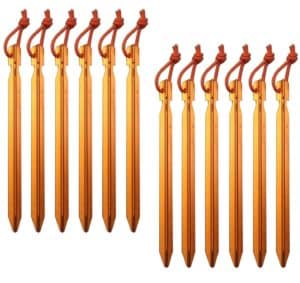 provide extra stability during rainy and windy weather. While plastic tent stakes will get the job done, metal tent stakes are more durable and will last longer compared to plastic tent stakes.
provide extra stability during rainy and windy weather. While plastic tent stakes will get the job done, metal tent stakes are more durable and will last longer compared to plastic tent stakes.
Best Tent Design to Withstand Rain and Wind While Camping
Tents can come in all different shapes and sizes but when looking for the best tent for rain and wind there is only one tent design that fits the bill, the dome tent.
There are several reasons the dome tent design is superior when it comes to rainy and windy weather. The first being dome tents have a lower center point than cabin style tents making them less susceptible to high winds because of their lower center of gravity. In addition dome style tents because of their shape provide extra strength and stability during rainy and windy weather. Because of the dome tents curved design, it disperses the weight and load more evenly across the tent and tent poles.
Best Tent for Rain and Wind Conclusion
Rainy and or windy weather can certainly bring additional challenges and issues while camping. As with everything else while camping though being prepared can make all the difference in the World and one of the best ways to be prepared for inclement weather is by making sure your tent is capable of handling whatever mother nature can throw its way.
